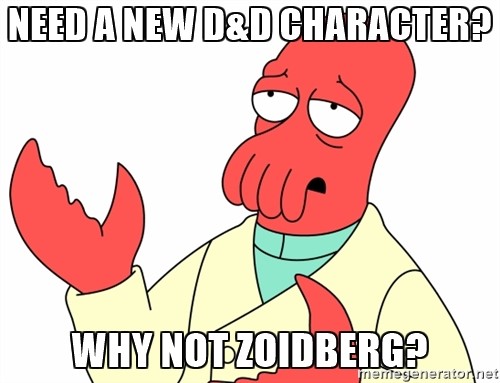 Character death is a natural part of any RPG experience. Anyone who lost a character is either new to roleplaying or has had overprotective DMs (rest assured that our most esteemed editor here at High Level Games could certainly never be accused of being overly, or even remotely for that matter, protective of his players). When a character dies, the player will rejoin the party mid-story with a new and often similarly powered character. However, these introductions are (at least in my experience) often awkward and contrived affairs. This is sad because, if I learned anything from high school literature, it’s that the introduction of a new character is often an interesting and memorable experience, even when it happens mid-story. For example, we all remember how Frodo and Sam met Merry and Pippin- literally running into each other in Farmer Maggot’s fields (in the movies, not the books). Or how did Luke and Obi-wan end up joining with Han Solo? Where else but in a sleazy bar on Tatooine (Han did in fact shoot first). These introductions not only helped define the new characters but were also memorable: Frodo didn’t look at Merry and Pippin on the way back to the Shire after destroying the One Ring asking ‘how did you guys end up traveling with me again?’ The following are a few tips on how DMs can make the introduction of a new character can actually enhance the group’s playing experience rather than fade into obscurity. 1. Place restrictions on character creation- While the ideal character creation might be for a player to create whatever their heart desires, it can easily lead to a contrived introduction to the group. Of course, any discrepancies can be explained away through backstory, but if you want the introduction of a character to be as seamless as possible, restrict what can be made to ensure it is story-friendly. Most groups (mine as well) already do this. Restrictions should be based on where the party is in the world or story. If they are in a Halfling shire or vampire coven, place a racial restriction on the new character. If the party is deep in the wilderness far flung from civilization, place a class restriction on the new character for classes oft found in the middle of nowhere (i.e. ranger or druid in D&D, wilderness scout or ley line walker for Rifts, etc.). Such restrictions are not particularly onerous or burdensome to the player, though they might be irritated if they had a specific character in mind, and can go a long way in easing the transition of a new character into the group so everyone can get back to adventuring. 2. Make the new character part of the story- How often in reliving the stories of old adventures are character introductions brought up? If it’s anything like my group, the answer is rarely. Introductions are such bland occurrences, just vehicles for the inclusion of a player into the group (be they of a recently deceased character or a new member), that at the end of a campaign we can no longer remember how our unlikely group of adventurers came together in the first place. Character introductions can easily become intrinsic and memorable parts of the story with a little help from the DM. One easy way is to assign the new character some additional knowledge, skills, and/or personal goals related to the group’s current quest. Thus, players would not need to contrive a reason for this new person to be added to the party. Furthermore, the DM could provide the player of the new character foreknowledge of what is going to happen in the main storyline; this will allow the player to make themselves useful to the party and contribute to advancing the story (similarly to Gollum becoming the Hobbits guide through the Emyn Muil and dead marshes). A more manipulative (but fun) way for the DM to introduce a character is to subject the party to certain death only to be rescued by the new player (i.e. Aragorn joining the hobbits at The Prancing Pony and leading them into the wild). With only a little bit of creativity from the DM, character introductions can cease to be the awkward affairs they typically are and happen naturally or even be a focal point in the story. 3. Assume control of an NPC- Rather than turning character introduction into a focal point in the story, having the new player play as an NPC already known by the party removes the inconvenience of introduction altogether. This can be a rather severe limitation on the player but can very much ease the process of character creation, as at least part of the stats, backstory, and personality are already in place, as well as their introduction into the party. These NPCs could really be anyone within the game world, though the more the NPC is known by and related to the group, the better. It could be a local noble who hired the heroes for a job, mercenary who helped the party on a previous quest, or a family member of one of the group. In a world rich with NPCs, players could have so many to choose from that such a limitation is not severe at all. With a little bit of prior planning, NPCs can be brought along with the party specifically to be assumed by the players of now-dead characters. They could be camp followers, guards for your gear, hired mercenaries, or local guides, just to name a few. Nothing is worse than having your character die in the first evening of a weekend-long dungeon crawl and then needing to create a new character while your friends are all having fun; the group then just happens to stumble on to this new character at random and have him or her join the group. Having a few NPCs accompany your party can provide a ready source of player material should the need arise. 4. Use the story to keep the character alive- I don’t advocate this to be used frequently, as without death as a factor in the game, there would be no consequence for rash action nor any emotional payoff for victory. However, there are a few instances where the introduction of a new character would be so inconvenient to the story that finding a way to keep the character alive is in the story’s best interest. This can be done in any number of ways, from the intervention of a god (think Gandalf become White) to a character only seeming dead (think Frodo after his encounter with Shelob). The context in which keeping a character alive might be a good idea could be if the group was in an extremely isolated location in which there wouldn’t be anyone else to join the group or if the loss of a character would bring the story to an abrupt and premature end. I would again suggest that this only be done if there is no other recourse, as improperly or excessively done it only removes the gravity that games go out of their way to create. There are many ways to deal with character death and introduction. Each group will just have to find what works for them. In a group where the story isn’t as important as the combat, having a seamless character introduction would mean little. However, for story-centric groups (like mine), a contrived introduction can seriously disrupt the gravitas and fluidity of the story. Decide what works best for your group and run with it. I’m going to go watch Lord of the Rings for the millionth time, as apparently it’s on my mind, as evidenced by the many references. Namaarie! - Jake is a great lover of role-playing games and fantasy in general. He lives in Texas with his wife and Lord of the Rings extended edition set on Blu-ray.
86dGamer
2/8/2016 09:16:49 pm
I prefer option 2.
Reply
Leave a Reply. |
All blog materials created and developed by the staff here at High Level Games Archives
April 2023
Categories
All
|
Proudly powered by Weebly



 RSS Feed
RSS Feed